Breezer TION O2: operating experience
▌Intro
The history of the banal - my street, once quiet and located on the outskirts of the park area, suddenly became very busy. Where previously it was possible to safely play football on the roadway, a car now passes every few seconds, and at rush hour it can be a traffic jam for the entire length of the street. And where the car, there is dust and noise. In general, it turned out to be absolutely impossible to open the windows in my workroom and bedroom - noisy. And I do not like noise. The wife so generally closes the window immediately, not even letting air out. Especially the situation was aggravated with the installation of plastic windows. If the old wooden ones were crooked and oblique, that you can stick your finger in the slit, then the new ones are sealed like in a refrigerator.
Needless to say that the gatherings at the computer in a closed room turned into a uniform such a gas chamber. Already after a couple of hours, there came the natural stuffiness, especially felt when you leave the room outside. Or, on the contrary, when from the street you enter there. The air conditioner is there, but it is absolutely not an assistant here. After all, it only cools the air already present in the room, chasing it in a circle through its radiator, but does not make it fresh, does not add oxygen.
There was a thought about the organization of some more advanced ventilation. The truth is, until the thought arose, while I decided that I needed it, while I got together and looked for existing solutions ... These things, from idea to implementation, I have years ...
')

But fortunately, as I have it, if Magomed does not go to the mountain, then the mountain itself rushes to it with a skip. Representatives of the TION company knocked me in the mail and made an offer I could not refuse - they put their ventilation system to me, and I write everything that I think about it. This they successfully entered.
▌Company
Initially , TION (Tion ... Tion ... where I already heard that name ...) specialized in serious medical ventilation systems for all kinds of operating theaters. Where it should be clean and sterile, but decided to learn and home segment. And therefore developed such a wonderful thing:
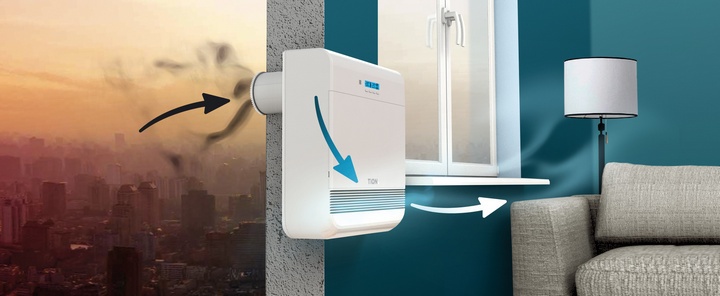
Brizer Tion O2 - apartment ventilation system. Which soaks up air outside, clears it with the whole pack of different filters, warms up (if it is necessary) and gives out to pleasure to inhabitants. This is the thing that I installed in the apartment, and I will share with you the experience of its operation.
▌ What's inside?
Externally, the breather looks like a box, quite impressive, something like an ATX MidiTower system builder, but a bit thinner. It is approximately 45 cm wide, 55 cm high and about 16 cm thick. Not small, in general, but rather light.
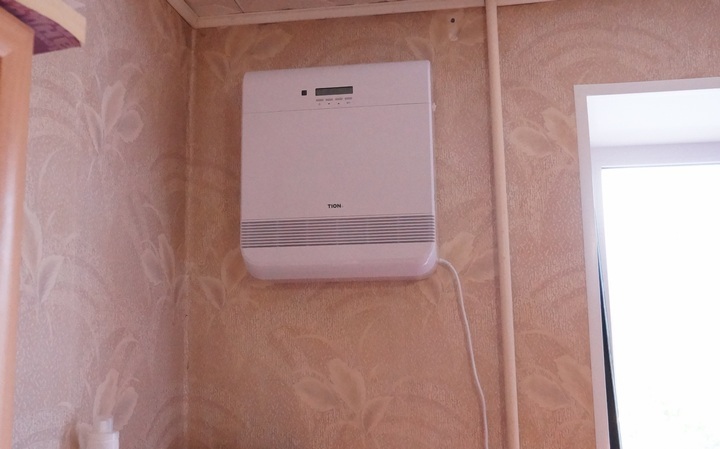
At the bottom of the fan slot, at the top of the display with buttons.

In the center is a hefty lid that is held by snaps and a magnet so that it does not visually stick out. Below it lies three filters standing across:
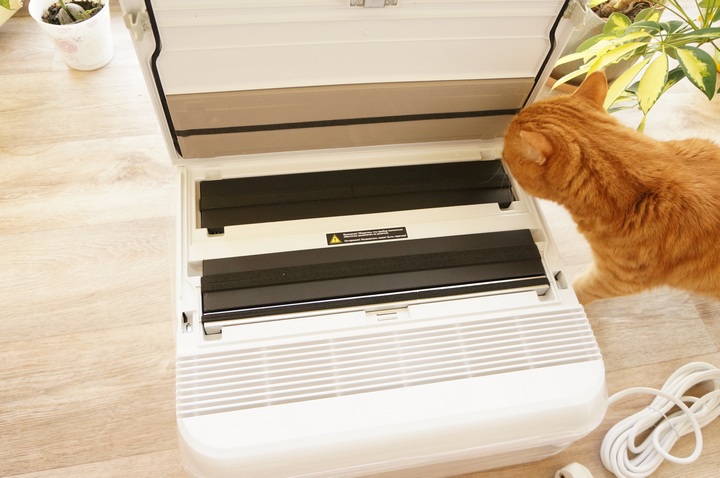
Here on this scheme, from top to bottom:
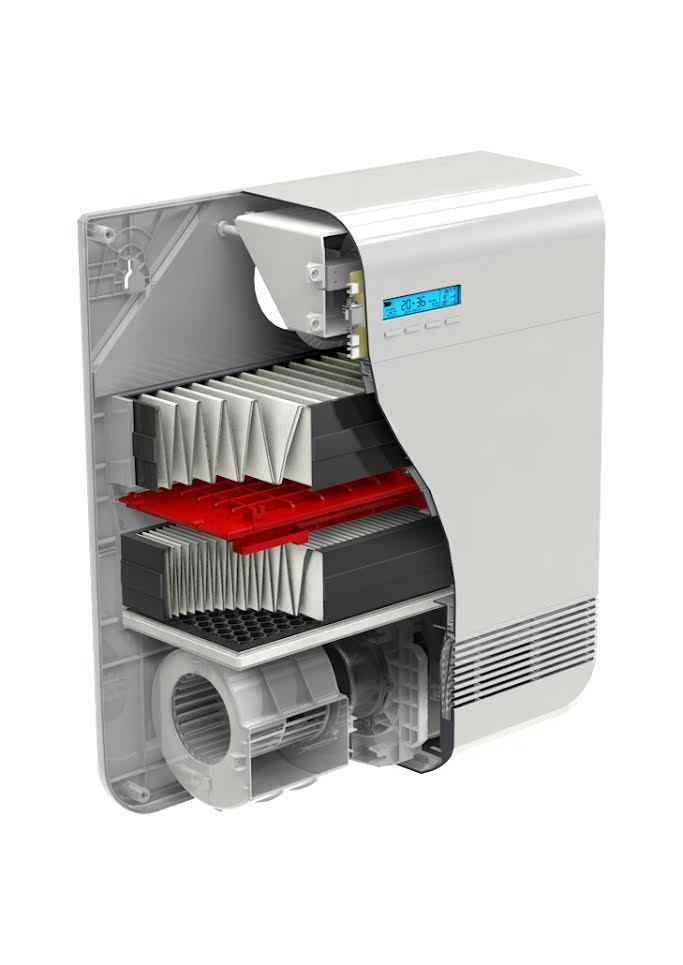
1 - Filter F7. This is a coarse filter. Coarse dust, poplar fluff and wool will get stuck in it. Density is similar to the car cabin filter. Its task is to protect the HEPA filter from clogging with large particles, since in this case it will not be able to work.
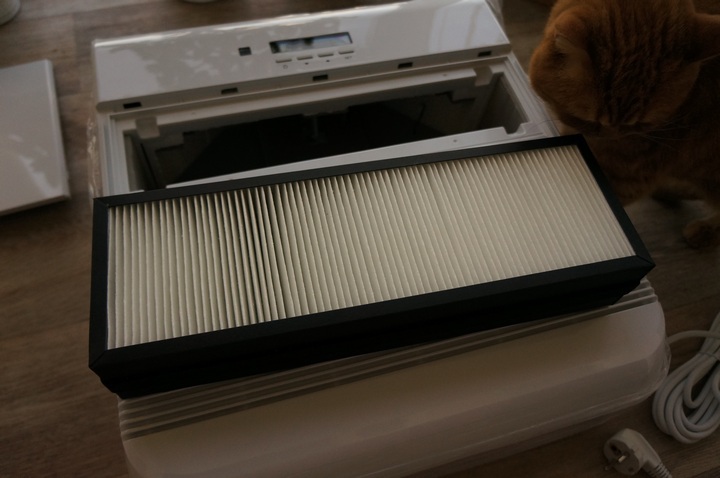
2 - HEPA11 filter. HEPA is an abbreviation for High Efficiency Particulate Air, and 11 is a filter class. For class 11, no more than 5000 pieces of particles are allowed up to 0.06 microns per liter of air. An interesting filter, the pore diameter in it is much larger than the diameter of the screened particles. The feature is that it delays the particles not by blunt screening on the size, but on the difference between the movement of particles and air. Somewhere inertia, the particle will bend around the channel and crash into the fiber, somewhere its electrostatics will attract the fiber, somewhere entangled in the vortex flows among the fibers. A little clearer about it was written earlier.
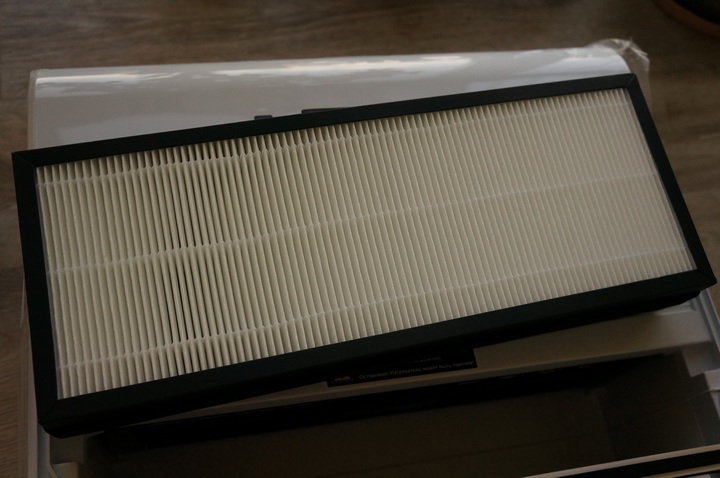
3 - Adsorption catalytic filter. It looks like a carbon filter, as in a gas mask. Its task is to trap exhaust fumes and industrial emissions.
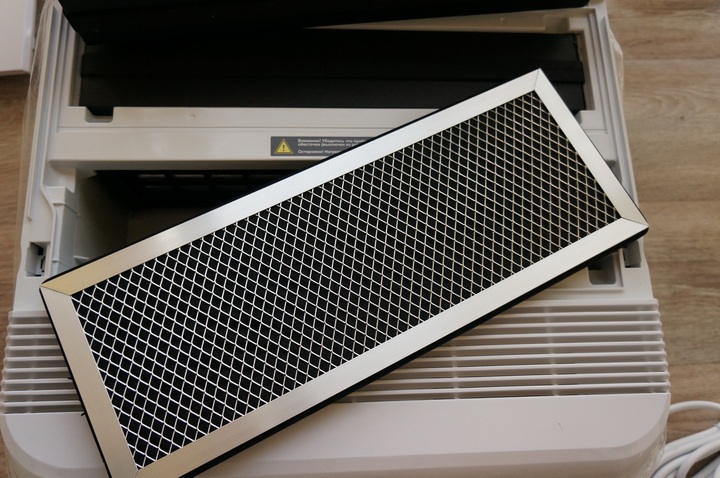
In front of the F7 filter, if you look inside, you will see a flap that automatically opens when the breather is operating. Thermal insulation of foam and hanging on the wiring temperature sensor.
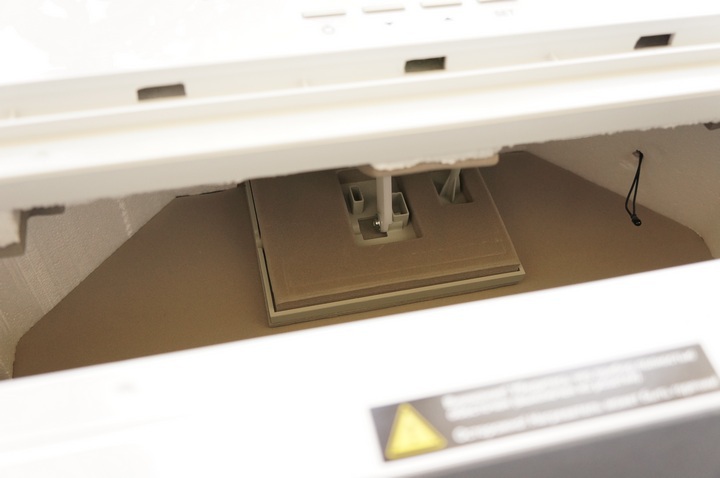
After the filter F7 is the heater grill. Its purpose is purely technical, it is not intended for space heating, its task is to heat cold air in winter to such a state that condensate does not form.

All ends with a fan impeller. The same is with us and in air conditioners.

On the reverse side we have a hole where the air intake comes, and on the side there is also a button for a mechanical power switch. And this is very good!

▌Montage
This is all great, of course, but how can you put this thing on the wall? You can punch the wall with a perforator, but it will be some kind of fierce medical style jamshuting. Without a gallant brigade with special equipment here is not enough. But, fortunately, in almost every city there is a company engaged in industrial ventilation. With the most intelligent and skillful companies, Tion concludes contracts, conducts training and master classes, and also strictly monitors the quality of the work performed.
The courier brought me a box with this white suitcase, a day later a representative of the drillers firm called, they agreed on the dates ... And here on my threshold are two fighters and a mountain of instrument HILTI. Polite, neat, in branded overalls. Were exhausted (!), Got a hefty industrial vacuum cleaner and started:
1) We determine the place. And with the help of the template that came with the breather, we pretend where the breather will stand, where there will be air duct openings, and where there will be holes for fasteners.
2) To mount a drilling rig, a powerful stud must be screwed into the wall. A hole is drilled under it with a perforator, about 30 mm in diameter, and a chemical anchor is placed there.
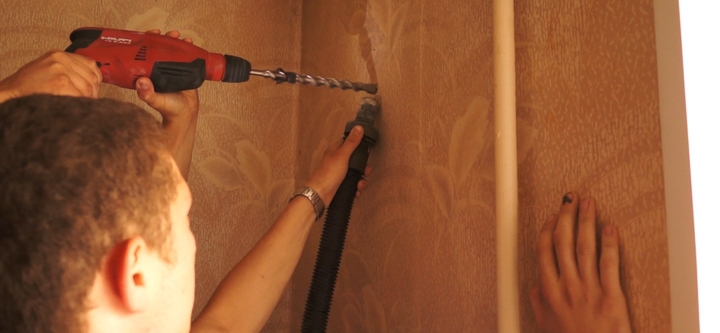
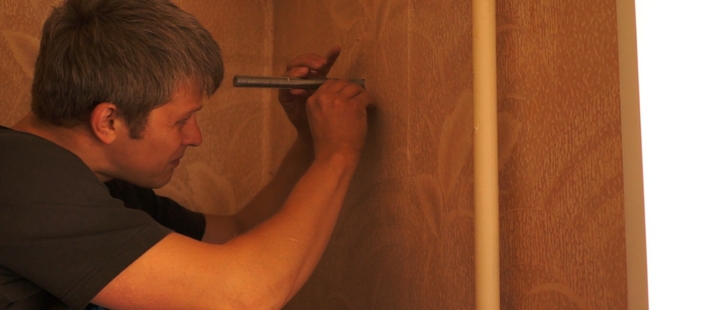
The anchor dries for about an hour, so I simply suggested that the installers drink tea, and they fed me with selected working bikes.
3) A drill bed is attached to the anchor. Luckily for me she didn’t come up against the regiment, otherwise she would have had to take it off. Consider this moment, that not everywhere you can crawl with this bandura. The bed is placed at a small angle so that the channel is tilted outward, and condensate, if it suddenly forms in the pipe, drains into the street.
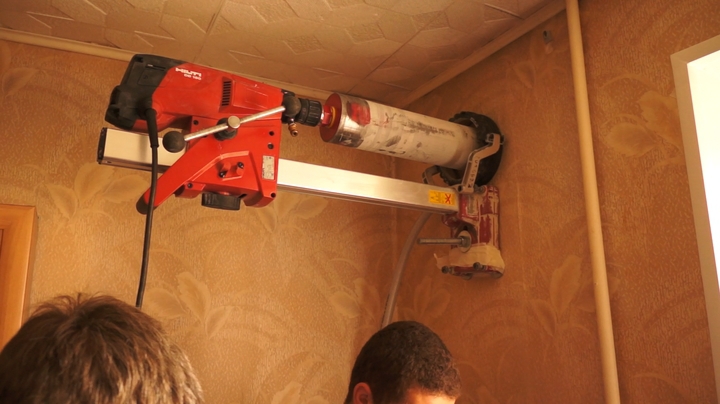
4) A water ring was attached to the wall, and a car was placed on the guide rail. In the process of drilling, water is fed to the drill, and this water, along with dust and dirt, is sucked off by a vacuum cleaner. As a result, no dust, no spray, no dirt. Only on the wallpaper remained wet circle around the hole. If the wallpaper would be washable or at least not as dull as mine (paper from the 90s), then there would be no trace at all.
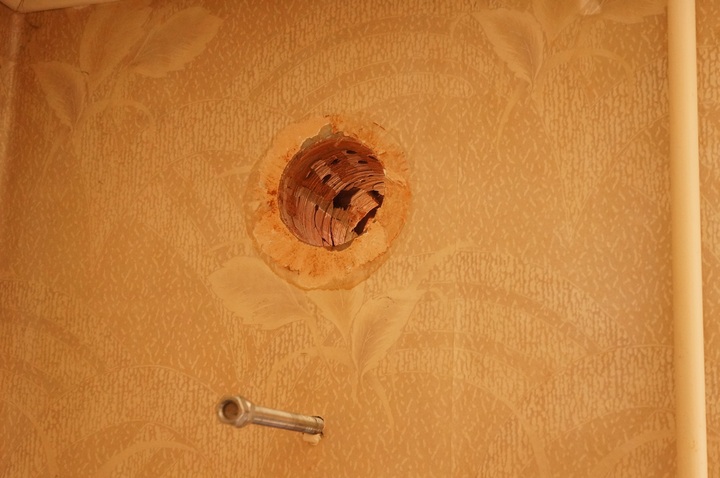
Compare it with how the wall was drilled without this ring in the Madrobots office and feel the difference :)
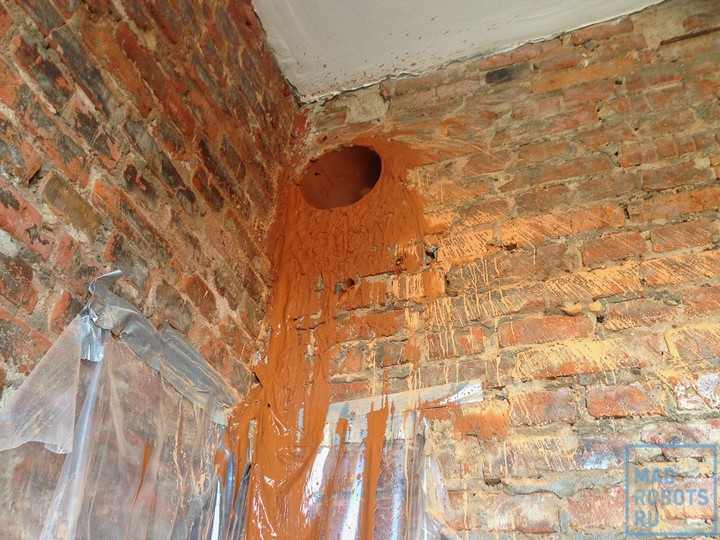
5) In the process of drilling the length of the drill was not enough. I have a brick house and a wall under the meter. I had to increase the drill and knock out a piece. But it was not a problem. The brick plug removed from the crown was packed in a green garbage bag and I did not see it again.
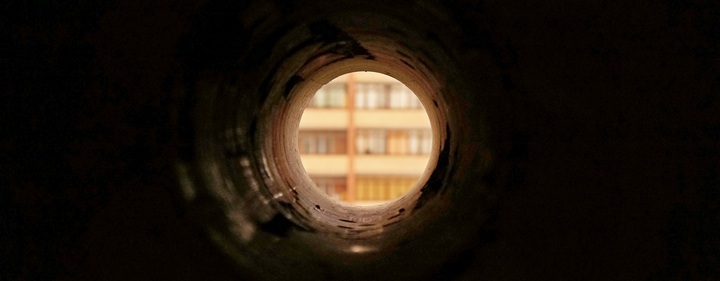
6) Heat insulation from a plastic pipe and polystyrene foam insulation glued to it was laid in the hole. I did not have time to shoot the pipe itself, but here everything is clear.
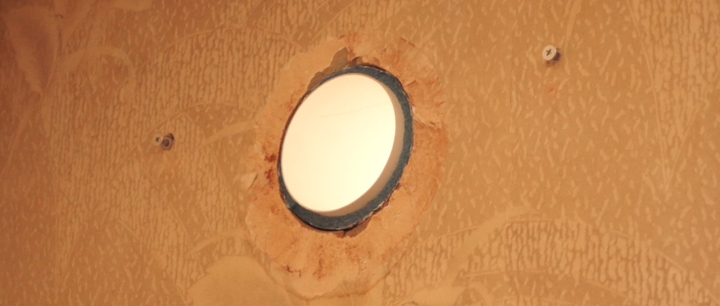
7) On the reverse side, a decorative grid was planted so that the birds would not nest any birds at all, and did not flood the rain, if that.
8) Then everything is elementary. The screws that come with the dowels are screwed into the wall, and the breather itself is hung on them. Remarkably, it can be removed at any time and then put on its own back. For example, if you need to change the wallpaper. No problem.
9) The device is plugged in - ready.
Although my room is in a state of sluggish repair, all the same, when drilling, everything was collected before the dust particle, and after installation it became cleaner than it was before. So mounting the breather with the right approach is an operation that is completely clean and does not lead to a total destroy in the apartment. No problem, you can do even fine finish.
Here is a little noisy video about how this happened:
Adjustment
For a couple of days I was happy with the work of the apparatus. It became really more pleasant to be in the room, and even with the doors closed, returning to the office was not perceived as an entrance to the stuffy room. And then I look - and something seems to be wrong with the breather. It seems to work, but I can not hear it at all. Click-click remote. Zero reaction. I went over, and on his display some kind of porridge, when I tried to add fan speed from the motor, there was a crash, as if dry leaves were poured in there. Turned off, turned on - the same story. Well, of course, the controller's brain was caked.
Judging by the picture, it looks like the controller's stall has failed. Chaotic execution of commands, but not complete paralysis. This happens if, for example, you forget to silence interrupts from external inputs, in the hope that they will never come. And they suddenly came. Well, you never know, a leak on the board. And the controller threw on the handler leading to nowhere ...
I am writing to the manufacturer: Houston, we have problems. I propose to throw out their guts and solder their own, a great article would come out. But they break me off and make a guarantee return. Eh ...
But he has mastered the hard way how the warranty service of the company TION works. It works well. Called, clarified the fault. Agreed to replace. A few days later the courier came running, brought a new device. The next day, in his packaging, the same courier took the faulty one.
▌ Operation
The device itself is easier to use. It may or may not work :) The entire interface is reduced to the power button, as well as the fan control buttons. I usually have it always turned on for 1 or 2 speeds. When it is almost not audible. This is enough to ensure a comfortable flow.
The interface of the device itself is also simple, like a sledgehammer. Its comprehensive description gives just one screenshot of the instructions:
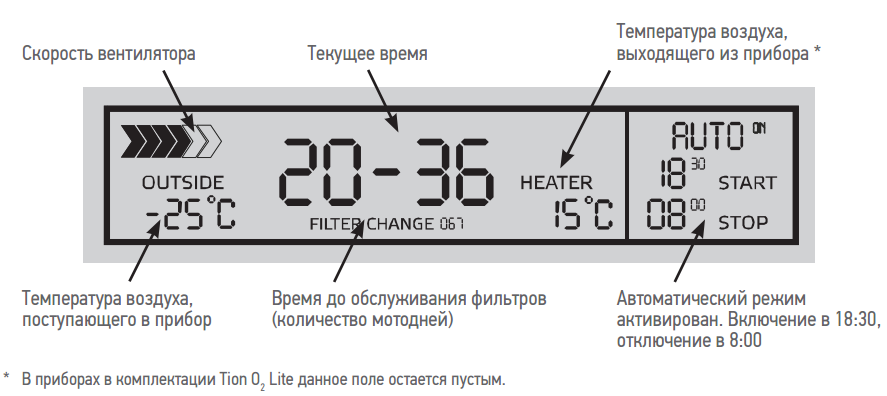
With buttons, we simply select the desired parameter in a circle and change it if necessary. On the remote control are the same four buttons. The temperature of the incoming air is also changing, in this case it is not forced climate change outside the window (and so wanted, yes), but a limit on the temperature of the incoming air. If you do not want the breather to turn your flat into a detox in case of sudden frosts, then set the minimum allowed work temperature, below which it will turn itself off. But we can influence the output air temperature by turning the air heater on or off. This is also set in the settings.
▌Dust and dust
I live in a good area, my forest almost from the yard begins, and then the lake. I am separated from major highways by a couple of blocks. So I don’t really complain about the dust and cinder, it didn’t soar me before, the more I live on the top floor.
It is true that occasionally in our city “unfavorable meteorological conditions” occur, as we call in the news emissions from steel mills. Well so throw over the phenol, formaldehyde, nitrogen dioxide.
I can not exactly describe how it smells, but it is such a characteristic "heavy" smell that does not have a clear taste. It looks like ozone after a thunderstorm, but it does not ache from ozone in the chest with a deep breath, unlike. Chelyabinsk know. In the apartment it does not feel much, only when you breathe right into the window.
And with the breather, I stopped feeling it at all. Even if you stick your nose under the exhaust fan. In the window is, from the breather there. Looks like a carbon filter and really taxis. In the TION catalog, by the way, there is a reinforced carbon filter, I think I will put it instead of HEPA11.
I wonder if he can suppress the fumes from burning peatlands or forest fires? A few years ago, this topic was very relevant in Moscow, even my brother’s asthmatic had to be urgently evacuated from there.
▌ Noise
The main argument in favor of supply systems for me was, as you remember, noise. The continuous ragged buzz of passing cars infuriates. And most importantly, in contrast to the dimensional buzz of the computer coolers or the same breather fan, I cannot ignore it. I bummed in Element (a store of radio components in Chelyabinsk) a noise detector and made a number of measurements. On the plan, he is depicted as a microphone.
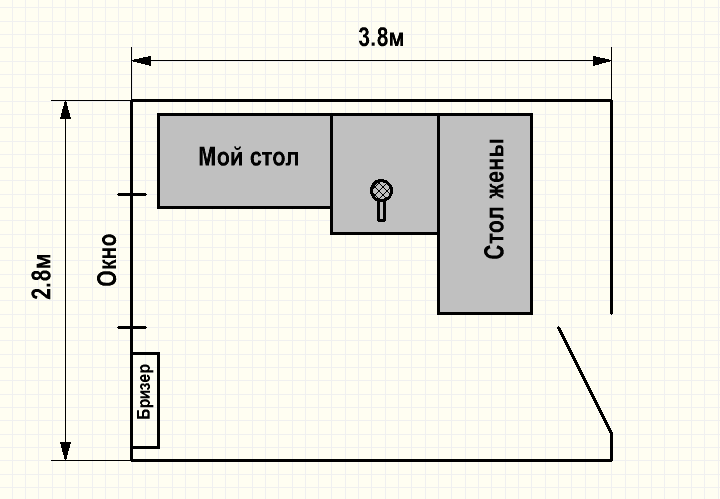
1) Background noise. Day, approximately 16:30. Moderate car traffic outside the window. Computers are turned off, breather is turned off, everything that can make noise is turned off. The window is tightly closed. I try not to breathe and not to make unnecessary movements. The room is definitely quiet. You can hear how the neighbor’s floor is flustered, how the cats walk in the next room.
The noise level around the table is 30dB. According to SNiP 23-03-2003 "Protection against noise", this is the maximum allowed by the standards for residential premises at night, from 23 to 7 hours.
2) I turn on the breather for the first speed, the smallest stroke. Hardly audible rotation. 33dB.
In the afternoon, when somewhere in the kitchen, he splashes water and rattles his wife with dishes, behind a closed window they drive cars, play something from the headphones, even if they are on the table, go there and scream the cats, the system unit is working (two HDDs, a quiet cooler Zalman 80mm at 1800 rpm, and the power supply Zalman ZM-450GS) - I cannot even determine from my workplace whether the breather is on or not. We have to come up and look, hand up to the lattice to feel the breath.
3) Second speed. The noise from the breather becomes apparent, but not to be called strong. 38dB.
Approximately as the minimum speed of the air conditioner. That is, if you pay attention to it, you can hear. But if at home there is some kind of everyday movement, then it is completely invisible. Some even leave this mode for the night, for example, one of the installers said that he had put the same breather in his bedroom, turned it on and forgot about it.
4) Third speed. Brizer noticeably buzzing. He is clearly audible. 43 ... 44dB.
It will be invisible if playing music or sitting in the headphones. If the TV is on or there is a conversation. It can be compared with a very noisy sistemnik. Remember, maybe there were such hellish Chrome Orb coolers, for the first Athlon Thunderbird processors went well, about 15 years ago. They cooled perfectly, but notably howled. Here it immediately reminded me :) On average, the same noise makes the air conditioner at the maximum. But the noise is uniform and easily ignored after a few minutes.
5) The fourth speed, it is also Turbo mode. Here the fan fries to the fullest and begins to howl noticeably. Delivering as much as 50dB of noise. This is a quick airing mode. I use it extremely rarely. Usually, a breather constantly running at low speed ensures sufficient freshness of the air.
6) It remains to be seen whether the game was worth the candle? Turn off the breather and open the window ... 50dB when driving one car. If it passes two at once, then it reaches 55dB, and if a truck passes by, rumbling with everything you can, then 70db. And this is my window still looks out onto a small bypass. But there are people who live here:

And every morning and evening an eight-lane traffic jam about 200 meters is observed under the window. The noise is such that it is sometimes impossible to talk outside, you have to shout. I would probably shoot myself there. Although a person gets used to everything.
And, finally, one video showing the measurement of the real noise picture. First, the computer turns on, you can hear how it accelerates the screws, then I turn on the breather, first to the maximum, and then reduce it to the minimum. Then turn off the breather and open the window.
▌Efficiency
Judging by the specification, the fan performance, depending on the model, is as follows:
Standard: 35/60/75/120 m3 / h
Base: 40/65/85/120 m3 / h
Lite: 40/65/85/130 m3 / h
The more filters in the model, the slower. Is logical. I have a Standard model, so we will dance from her. Let's estimate very roughly, on the fingers ...
So, my room size is 2.8 x 3.8 x 2.6, i.e. about 28 cubes of its volume. This means that in an hour, even on the weakest mode, the breather will completely replace the air in the room. Injecting fresh and replacing the one that was. A person inhales about 2 liters at a time at a time, makes about 12 breaths per minute (in a calm state), that is, pumps about 1.5 cubes per hour through himself. That is, even at the slowest speed, we will definitely not die, we can start the experiments :)
For quantitative analysis, comrades from TION gave me a temporary measure of this:

She knows how to write logs and dump them on the PC. After that, I fed them to gnuplot and drew graphics. To set the zero point of reference in the experiments, that is, some ideal conditions, I dragged this puck to the country and measured the CO 2 content in the middle of the pine forest. The minimum I could detect was 400ppm. I took him for zero.
First of all, I thoroughly ventilated the room, blowing out powerful drafts with everything I could, having achieved the minimum CO 2 values, then closed all the windows, closed the door to the room, and the two of us and my wife buried our computers. Need to know how it can bring? And logger obediently wrote the data ... After a few hours, the CO 2 concentration reached 3200ppm, and it felt like real stuffiness. That is, you leave the room - and as if you walked out onto the street. Wow, immediately freshness, that I absolutely do not want to go back.
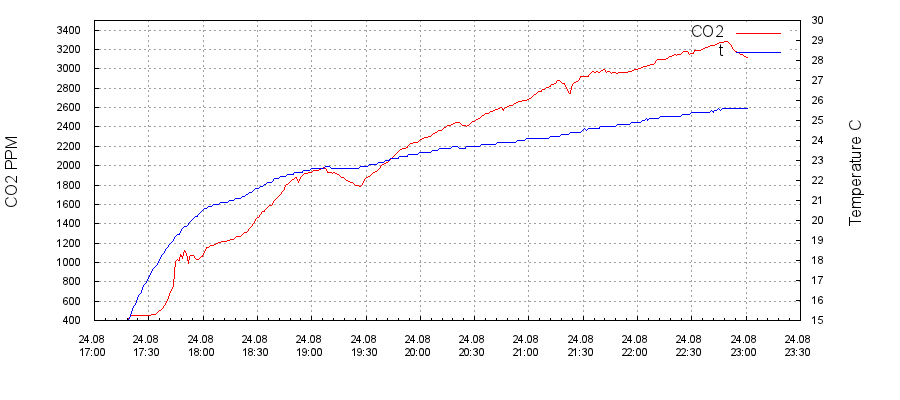
Small dips on the charts are going to and from the room. The device is damn sensitive, and even the slightest opening of the door for a few seconds is immediately reflected on the graph. If you link it with the sensors for opening doors, windows, the operating mode of the inflow, as well as typing statistics and conjuring over the algorithms, you can get a very accurate sensor of the presence of people. For example, for a smart home.
In general, for myself, I roughly estimated that the level of CO 2 in the room, which is not felt by walking back and forth, is somewhere up to 2000 ppm.
The next stage I turned on the breather at the minimum speed, and in a few hours it blew the room, refreshing the air to make sane values.My wife went to bed, and I stayed until that morning for some reason.
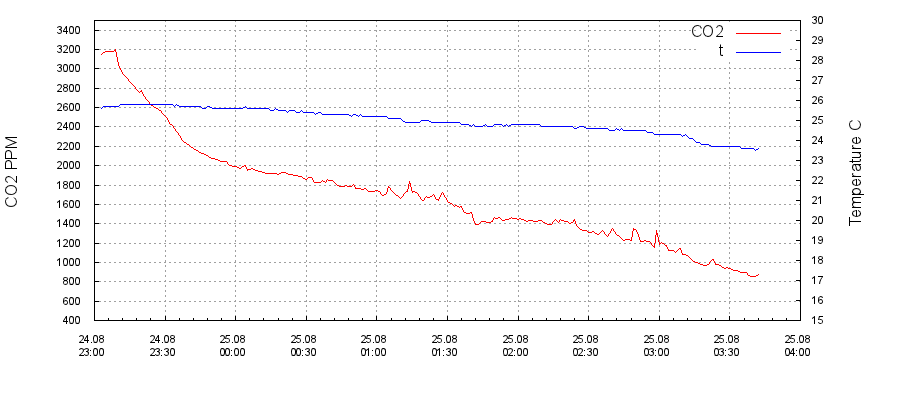
The following experiment, I decided to find out how much you can breathe with the door open. In the same way, I made a powerful blow through with a draft (a sharp failure at the beginning of the chart) for about half an hour, and then closed the window, but left the door to the rest of the apartment open. I have a small apartment, a treshka of meters at 60. It occupies the entire width of the house, so that my windows face both ways. Perhaps two windows on the balcony were also opened, but they, as practice has shown, have practically no effect on small (up to 10 hours) time intervals. Breather was off.

In principle, it was quite tolerable. Two people in an open room can not create a tangible stuffiness. Although the sensor blinked all the time and complained that the pier had to be aired, but it did not soar me. Above 2000 ppm, the concentration of carbon dioxide did not rise.
The experiment was decided to continue. The window in the office was still closed, but this time it was monitored for three days without a breather. The door to the room was open and closed. Basically there were two people in the room. Wife yes I am.
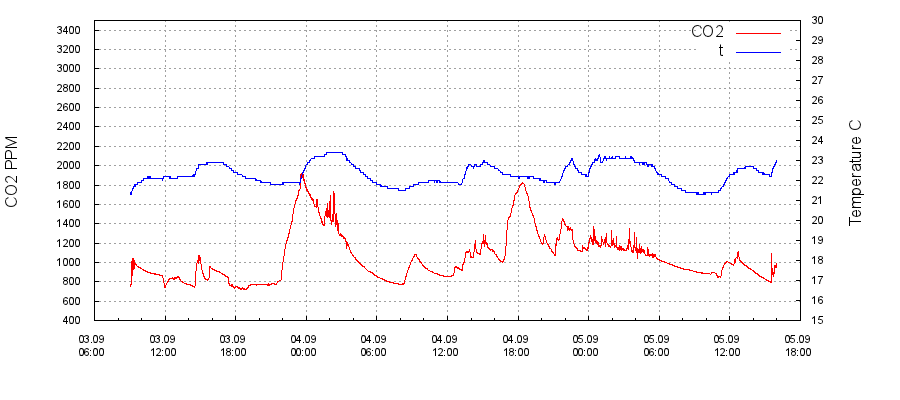
Then I turned on the breather on the weakest mode. And he repeated the experiment:
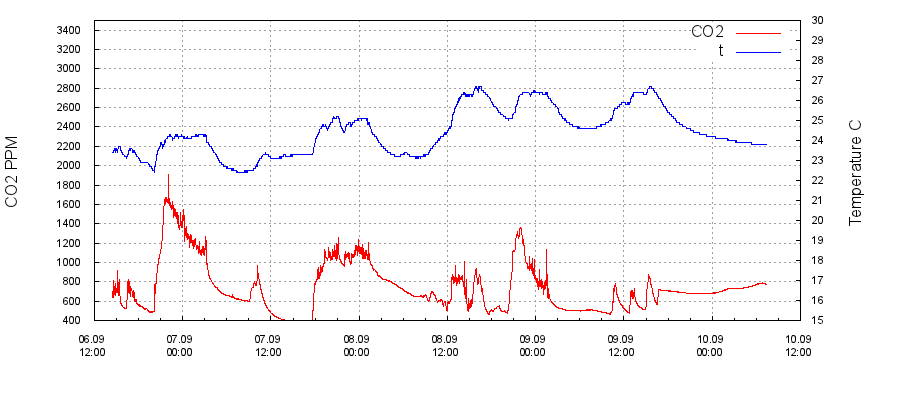
The room became noticeably fresh, in numbers. As I wrote above, below 2000 ppm, the difference is not felt in any way. Doctors, of course, can have their own opinion on this.
I also decided to conduct a comparative test in which I drove my office through several different ventilation options. Here's what I got from this:
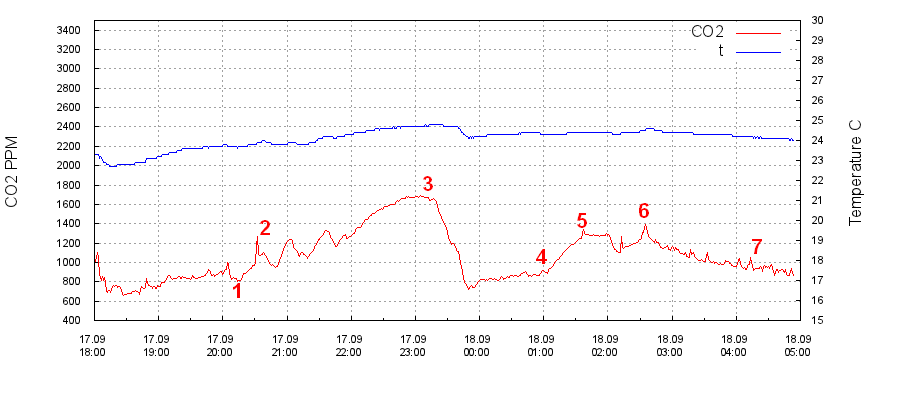
At first I just opened the window. On airing. Tilting the sash. The door to the room was closed. At about 20:19 I felt cold, and I covered the window, not completely, leaving a gap with two fingers wide (1). At 20.45 (2) the wife opened the door and forgot to close. Then there were walking back and forth, the next two failures are related to the fact that we both left the room. At about 10:00 pm we both returned to the room and closed the door. At 23:17 (3) I looked at the device and opened the window, again for airing. The level fell sharply to the level of the beginning of the experiment. At about one in the morning (4) I finally closed the window and turned on the breather. On the weakest mode. But with the door closed, this was obviously not enough for two people. And looking at the increase in concentration of CO 2, I at 1:36 (5) added speed on one step, including on the second. The system immediately came to equilibrium. That is, at the second speed the breather delivers fresh air exactly for two. Funny.After a little running around, Masha, at 02:43 (6), fell off to sleep. The level of CO 2 in the room immediately began to decline. At 03:51 (7) I added more speed, but not to say that it had some effect. In general, the room is ventilated nonlinearly. High concentrations of CO 2 can be quickly and easily brought down, but it’s extremely difficult to ventilate to the street level.
Well, a couple more experiments, I spent on a quick airing. Comparing the window open for airing and breather at maximum speed. The experiment was similar. First, we cork in the room, maximize concentration, and then reset it by opening the window. There are still two people in the room:
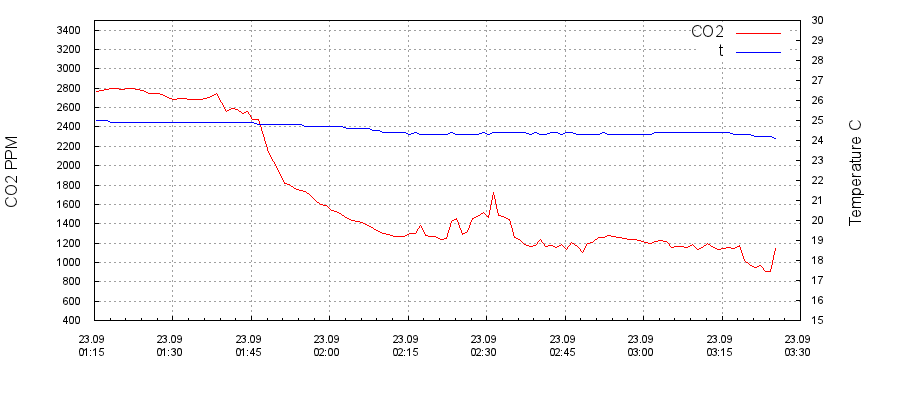
Or including a breather for maximum:

Breather cope significantly faster. With that, when I ventilated the window, it was quite windy outside the window, and although there was no draft, it was always unpleasant to blow out of the window at me. In winter, even when opening the vents, there will be a temperature drop, as the warm air rushes through the window, and the carbonic acid that hangs down below will disappear much slower. But there will still be winter trials, but for now.
▌ Disadvantages
Where do without them.The most important jig of the breather is that it is still a stationary device, like an air conditioner. But the power cord is like an iron, but most importantly it comes out on the side, and it is not even beautiful to cut it off. There is no way to make a niche for it on the reverse side, put a terminal there, you want to plug it into the outlet, and you want to bring the wiring individually.
Inconvenient indication of work, or rather its absence. My breather hangs under the ceiling, and on the quietest mode hell guess whether it works or not. It is necessary to approach, examine what is there on the dark display. There would be no indicator of what was, diode. Yes, even if the lights a little smoldering. Brightly it is not necessary, you never know what is hanging in the bedroom and will hit your eyes. But a little highlight, so that it was barely visible. Then it will be clear from below whether it works or not. Just by shading the display. A business programmer for five minutes - Shimka to throw backlighting and that's it.
The next thing that freezes me is the clock. No, I understand why there is a clock, setting timers and other things. But in the modern world is full of hours. I have a clock in my room on my computer, on my phones, in the kitchen, they are in the microwave, and the devil still knows where. Now there is a breather. Well, all right, there is and all right. But there is a much more interesting parameter on the breather - the outside air temperature. This is much more rare guest in the apartment. Why not put this indicator on the main dial, in large numbers, and push the watch somewhere in the corner? Recently I prefer to watch the temperature on the street on the breather screen, but these small numbers have to be literally examined. And with the backlight turned off, it is also possible to pull the remote control to light the display.
Few blowing modes. Perhaps this is due to the engine speed control mechanism, it is probably asynchronous, and not everything is so simple with it. There is not much regulation on switching the windings, but if there is frequency control there and this can be solved programmatically, then it is necessary to decide. There is a lack of a couple of intermediate modes. For example, the speed is greater than 1, but less than 2.
I would like the curtains controlling the flow, at least to the left-right. So that you can turn away the incoming cold air.
It is also floating that in the event of a power outage the breather turns off, but then it does not turn on itself. It always works for me, it does not turn off for a second. I do not remember its existence at all. Works and pleases. And with electricity in my apartment some kind of trouble. Always cut off for a minute or two. It happens once a week. And this is cut down by the breather, which I notice only when the room really becomes stuffy.
▌Conclusion
What can I personally say about my impressions of the device? I like it. Of course, I did not conduct any benchmarking or evaluations of competing solutions, since the device itself came to me. But he solved my problem with noise and ventilation of the office completely. I now open the window, only to wash it, even the neighbor below, who smokes through the window, has ceased to show himself somehow. The noise of transport and the stench of metallurgical production, too, were left somewhere overboard. The device itself is quiet, I forgot about it already. It works and works. This is exactly what home appliances should be - invisible. Would I put it myself for my money? Yes, I would. And probably put. To another room, if it ever becomes habitable.

The history of the banal - my street, once quiet and located on the outskirts of the park area, suddenly became very busy. Where previously it was possible to safely play football on the roadway, a car now passes every few seconds, and at rush hour it can be a traffic jam for the entire length of the street. And where the car, there is dust and noise. In general, it turned out to be absolutely impossible to open the windows in my workroom and bedroom - noisy. And I do not like noise. The wife so generally closes the window immediately, not even letting air out. Especially the situation was aggravated with the installation of plastic windows. If the old wooden ones were crooked and oblique, that you can stick your finger in the slit, then the new ones are sealed like in a refrigerator.
Needless to say that the gatherings at the computer in a closed room turned into a uniform such a gas chamber. Already after a couple of hours, there came the natural stuffiness, especially felt when you leave the room outside. Or, on the contrary, when from the street you enter there. The air conditioner is there, but it is absolutely not an assistant here. After all, it only cools the air already present in the room, chasing it in a circle through its radiator, but does not make it fresh, does not add oxygen.
There was a thought about the organization of some more advanced ventilation. The truth is, until the thought arose, while I decided that I needed it, while I got together and looked for existing solutions ... These things, from idea to implementation, I have years ...
')
But fortunately, as I have it, if Magomed does not go to the mountain, then the mountain itself rushes to it with a skip. Representatives of the TION company knocked me in the mail and made an offer I could not refuse - they put their ventilation system to me, and I write everything that I think about it. This they successfully entered.
▌Company
Initially , TION (Tion ... Tion ... where I already heard that name ...) specialized in serious medical ventilation systems for all kinds of operating theaters. Where it should be clean and sterile, but decided to learn and home segment. And therefore developed such a wonderful thing:

Brizer Tion O2 - apartment ventilation system. Which soaks up air outside, clears it with the whole pack of different filters, warms up (if it is necessary) and gives out to pleasure to inhabitants. This is the thing that I installed in the apartment, and I will share with you the experience of its operation.
▌ What's inside?
Externally, the breather looks like a box, quite impressive, something like an ATX MidiTower system builder, but a bit thinner. It is approximately 45 cm wide, 55 cm high and about 16 cm thick. Not small, in general, but rather light.
At the bottom of the fan slot, at the top of the display with buttons.

In the center is a hefty lid that is held by snaps and a magnet so that it does not visually stick out. Below it lies three filters standing across:

Here on this scheme, from top to bottom:

1 - Filter F7. This is a coarse filter. Coarse dust, poplar fluff and wool will get stuck in it. Density is similar to the car cabin filter. Its task is to protect the HEPA filter from clogging with large particles, since in this case it will not be able to work.

2 - HEPA11 filter. HEPA is an abbreviation for High Efficiency Particulate Air, and 11 is a filter class. For class 11, no more than 5000 pieces of particles are allowed up to 0.06 microns per liter of air. An interesting filter, the pore diameter in it is much larger than the diameter of the screened particles. The feature is that it delays the particles not by blunt screening on the size, but on the difference between the movement of particles and air. Somewhere inertia, the particle will bend around the channel and crash into the fiber, somewhere its electrostatics will attract the fiber, somewhere entangled in the vortex flows among the fibers. A little clearer about it was written earlier.

3 - Adsorption catalytic filter. It looks like a carbon filter, as in a gas mask. Its task is to trap exhaust fumes and industrial emissions.

In front of the F7 filter, if you look inside, you will see a flap that automatically opens when the breather is operating. Thermal insulation of foam and hanging on the wiring temperature sensor.

After the filter F7 is the heater grill. Its purpose is purely technical, it is not intended for space heating, its task is to heat cold air in winter to such a state that condensate does not form.

All ends with a fan impeller. The same is with us and in air conditioners.

On the reverse side we have a hole where the air intake comes, and on the side there is also a button for a mechanical power switch. And this is very good!

▌Montage
This is all great, of course, but how can you put this thing on the wall? You can punch the wall with a perforator, but it will be some kind of fierce medical style jamshuting. Without a gallant brigade with special equipment here is not enough. But, fortunately, in almost every city there is a company engaged in industrial ventilation. With the most intelligent and skillful companies, Tion concludes contracts, conducts training and master classes, and also strictly monitors the quality of the work performed.
The courier brought me a box with this white suitcase, a day later a representative of the drillers firm called, they agreed on the dates ... And here on my threshold are two fighters and a mountain of instrument HILTI. Polite, neat, in branded overalls. Were exhausted (!), Got a hefty industrial vacuum cleaner and started:
1) We determine the place. And with the help of the template that came with the breather, we pretend where the breather will stand, where there will be air duct openings, and where there will be holes for fasteners.
2) To mount a drilling rig, a powerful stud must be screwed into the wall. A hole is drilled under it with a perforator, about 30 mm in diameter, and a chemical anchor is placed there.


The anchor dries for about an hour, so I simply suggested that the installers drink tea, and they fed me with selected working bikes.
3) A drill bed is attached to the anchor. Luckily for me she didn’t come up against the regiment, otherwise she would have had to take it off. Consider this moment, that not everywhere you can crawl with this bandura. The bed is placed at a small angle so that the channel is tilted outward, and condensate, if it suddenly forms in the pipe, drains into the street.

4) A water ring was attached to the wall, and a car was placed on the guide rail. In the process of drilling, water is fed to the drill, and this water, along with dust and dirt, is sucked off by a vacuum cleaner. As a result, no dust, no spray, no dirt. Only on the wallpaper remained wet circle around the hole. If the wallpaper would be washable or at least not as dull as mine (paper from the 90s), then there would be no trace at all.

Compare it with how the wall was drilled without this ring in the Madrobots office and feel the difference :)

5) In the process of drilling the length of the drill was not enough. I have a brick house and a wall under the meter. I had to increase the drill and knock out a piece. But it was not a problem. The brick plug removed from the crown was packed in a green garbage bag and I did not see it again.

6) Heat insulation from a plastic pipe and polystyrene foam insulation glued to it was laid in the hole. I did not have time to shoot the pipe itself, but here everything is clear.

7) On the reverse side, a decorative grid was planted so that the birds would not nest any birds at all, and did not flood the rain, if that.
8) Then everything is elementary. The screws that come with the dowels are screwed into the wall, and the breather itself is hung on them. Remarkably, it can be removed at any time and then put on its own back. For example, if you need to change the wallpaper. No problem.
9) The device is plugged in - ready.
Although my room is in a state of sluggish repair, all the same, when drilling, everything was collected before the dust particle, and after installation it became cleaner than it was before. So mounting the breather with the right approach is an operation that is completely clean and does not lead to a total destroy in the apartment. No problem, you can do even fine finish.
Here is a little noisy video about how this happened:
Adjustment
For a couple of days I was happy with the work of the apparatus. It became really more pleasant to be in the room, and even with the doors closed, returning to the office was not perceived as an entrance to the stuffy room. And then I look - and something seems to be wrong with the breather. It seems to work, but I can not hear it at all. Click-click remote. Zero reaction. I went over, and on his display some kind of porridge, when I tried to add fan speed from the motor, there was a crash, as if dry leaves were poured in there. Turned off, turned on - the same story. Well, of course, the controller's brain was caked.
Judging by the picture, it looks like the controller's stall has failed. Chaotic execution of commands, but not complete paralysis. This happens if, for example, you forget to silence interrupts from external inputs, in the hope that they will never come. And they suddenly came. Well, you never know, a leak on the board. And the controller threw on the handler leading to nowhere ...
I am writing to the manufacturer: Houston, we have problems. I propose to throw out their guts and solder their own, a great article would come out. But they break me off and make a guarantee return. Eh ...
But he has mastered the hard way how the warranty service of the company TION works. It works well. Called, clarified the fault. Agreed to replace. A few days later the courier came running, brought a new device. The next day, in his packaging, the same courier took the faulty one.
▌ Operation
The device itself is easier to use. It may or may not work :) The entire interface is reduced to the power button, as well as the fan control buttons. I usually have it always turned on for 1 or 2 speeds. When it is almost not audible. This is enough to ensure a comfortable flow.
The interface of the device itself is also simple, like a sledgehammer. Its comprehensive description gives just one screenshot of the instructions:

With buttons, we simply select the desired parameter in a circle and change it if necessary. On the remote control are the same four buttons. The temperature of the incoming air is also changing, in this case it is not forced climate change outside the window (and so wanted, yes), but a limit on the temperature of the incoming air. If you do not want the breather to turn your flat into a detox in case of sudden frosts, then set the minimum allowed work temperature, below which it will turn itself off. But we can influence the output air temperature by turning the air heater on or off. This is also set in the settings.
▌Dust and dust
I live in a good area, my forest almost from the yard begins, and then the lake. I am separated from major highways by a couple of blocks. So I don’t really complain about the dust and cinder, it didn’t soar me before, the more I live on the top floor.
It is true that occasionally in our city “unfavorable meteorological conditions” occur, as we call in the news emissions from steel mills. Well so throw over the phenol, formaldehyde, nitrogen dioxide.
I can not exactly describe how it smells, but it is such a characteristic "heavy" smell that does not have a clear taste. It looks like ozone after a thunderstorm, but it does not ache from ozone in the chest with a deep breath, unlike. Chelyabinsk know. In the apartment it does not feel much, only when you breathe right into the window.
And with the breather, I stopped feeling it at all. Even if you stick your nose under the exhaust fan. In the window is, from the breather there. Looks like a carbon filter and really taxis. In the TION catalog, by the way, there is a reinforced carbon filter, I think I will put it instead of HEPA11.
I wonder if he can suppress the fumes from burning peatlands or forest fires? A few years ago, this topic was very relevant in Moscow, even my brother’s asthmatic had to be urgently evacuated from there.
▌ Noise
The main argument in favor of supply systems for me was, as you remember, noise. The continuous ragged buzz of passing cars infuriates. And most importantly, in contrast to the dimensional buzz of the computer coolers or the same breather fan, I cannot ignore it. I bummed in Element (a store of radio components in Chelyabinsk) a noise detector and made a number of measurements. On the plan, he is depicted as a microphone.

1) Background noise. Day, approximately 16:30. Moderate car traffic outside the window. Computers are turned off, breather is turned off, everything that can make noise is turned off. The window is tightly closed. I try not to breathe and not to make unnecessary movements. The room is definitely quiet. You can hear how the neighbor’s floor is flustered, how the cats walk in the next room.
The noise level around the table is 30dB. According to SNiP 23-03-2003 "Protection against noise", this is the maximum allowed by the standards for residential premises at night, from 23 to 7 hours.
2) I turn on the breather for the first speed, the smallest stroke. Hardly audible rotation. 33dB.
In the afternoon, when somewhere in the kitchen, he splashes water and rattles his wife with dishes, behind a closed window they drive cars, play something from the headphones, even if they are on the table, go there and scream the cats, the system unit is working (two HDDs, a quiet cooler Zalman 80mm at 1800 rpm, and the power supply Zalman ZM-450GS) - I cannot even determine from my workplace whether the breather is on or not. We have to come up and look, hand up to the lattice to feel the breath.
3) Second speed. The noise from the breather becomes apparent, but not to be called strong. 38dB.
Approximately as the minimum speed of the air conditioner. That is, if you pay attention to it, you can hear. But if at home there is some kind of everyday movement, then it is completely invisible. Some even leave this mode for the night, for example, one of the installers said that he had put the same breather in his bedroom, turned it on and forgot about it.
4) Third speed. Brizer noticeably buzzing. He is clearly audible. 43 ... 44dB.
It will be invisible if playing music or sitting in the headphones. If the TV is on or there is a conversation. It can be compared with a very noisy sistemnik. Remember, maybe there were such hellish Chrome Orb coolers, for the first Athlon Thunderbird processors went well, about 15 years ago. They cooled perfectly, but notably howled. Here it immediately reminded me :) On average, the same noise makes the air conditioner at the maximum. But the noise is uniform and easily ignored after a few minutes.
5) The fourth speed, it is also Turbo mode. Here the fan fries to the fullest and begins to howl noticeably. Delivering as much as 50dB of noise. This is a quick airing mode. I use it extremely rarely. Usually, a breather constantly running at low speed ensures sufficient freshness of the air.
6) It remains to be seen whether the game was worth the candle? Turn off the breather and open the window ... 50dB when driving one car. If it passes two at once, then it reaches 55dB, and if a truck passes by, rumbling with everything you can, then 70db. And this is my window still looks out onto a small bypass. But there are people who live here:

And every morning and evening an eight-lane traffic jam about 200 meters is observed under the window. The noise is such that it is sometimes impossible to talk outside, you have to shout. I would probably shoot myself there. Although a person gets used to everything.
And, finally, one video showing the measurement of the real noise picture. First, the computer turns on, you can hear how it accelerates the screws, then I turn on the breather, first to the maximum, and then reduce it to the minimum. Then turn off the breather and open the window.
▌Efficiency
Judging by the specification, the fan performance, depending on the model, is as follows:
Standard: 35/60/75/120 m3 / h
Base: 40/65/85/120 m3 / h
Lite: 40/65/85/130 m3 / h
The more filters in the model, the slower. Is logical. I have a Standard model, so we will dance from her. Let's estimate very roughly, on the fingers ...
So, my room size is 2.8 x 3.8 x 2.6, i.e. about 28 cubes of its volume. This means that in an hour, even on the weakest mode, the breather will completely replace the air in the room. Injecting fresh and replacing the one that was. A person inhales about 2 liters at a time at a time, makes about 12 breaths per minute (in a calm state), that is, pumps about 1.5 cubes per hour through himself. That is, even at the slowest speed, we will definitely not die, we can start the experiments :)
For quantitative analysis, comrades from TION gave me a temporary measure of this:

She knows how to write logs and dump them on the PC. After that, I fed them to gnuplot and drew graphics. To set the zero point of reference in the experiments, that is, some ideal conditions, I dragged this puck to the country and measured the CO 2 content in the middle of the pine forest. The minimum I could detect was 400ppm. I took him for zero.
First of all, I thoroughly ventilated the room, blowing out powerful drafts with everything I could, having achieved the minimum CO 2 values, then closed all the windows, closed the door to the room, and the two of us and my wife buried our computers. Need to know how it can bring? And logger obediently wrote the data ... After a few hours, the CO 2 concentration reached 3200ppm, and it felt like real stuffiness. That is, you leave the room - and as if you walked out onto the street. Wow, immediately freshness, that I absolutely do not want to go back.

Small dips on the charts are going to and from the room. The device is damn sensitive, and even the slightest opening of the door for a few seconds is immediately reflected on the graph. If you link it with the sensors for opening doors, windows, the operating mode of the inflow, as well as typing statistics and conjuring over the algorithms, you can get a very accurate sensor of the presence of people. For example, for a smart home.
In general, for myself, I roughly estimated that the level of CO 2 in the room, which is not felt by walking back and forth, is somewhere up to 2000 ppm.
The next stage I turned on the breather at the minimum speed, and in a few hours it blew the room, refreshing the air to make sane values.My wife went to bed, and I stayed until that morning for some reason.

The following experiment, I decided to find out how much you can breathe with the door open. In the same way, I made a powerful blow through with a draft (a sharp failure at the beginning of the chart) for about half an hour, and then closed the window, but left the door to the rest of the apartment open. I have a small apartment, a treshka of meters at 60. It occupies the entire width of the house, so that my windows face both ways. Perhaps two windows on the balcony were also opened, but they, as practice has shown, have practically no effect on small (up to 10 hours) time intervals. Breather was off.

In principle, it was quite tolerable. Two people in an open room can not create a tangible stuffiness. Although the sensor blinked all the time and complained that the pier had to be aired, but it did not soar me. Above 2000 ppm, the concentration of carbon dioxide did not rise.
The experiment was decided to continue. The window in the office was still closed, but this time it was monitored for three days without a breather. The door to the room was open and closed. Basically there were two people in the room. Wife yes I am.

Then I turned on the breather on the weakest mode. And he repeated the experiment:

The room became noticeably fresh, in numbers. As I wrote above, below 2000 ppm, the difference is not felt in any way. Doctors, of course, can have their own opinion on this.
I also decided to conduct a comparative test in which I drove my office through several different ventilation options. Here's what I got from this:

At first I just opened the window. On airing. Tilting the sash. The door to the room was closed. At about 20:19 I felt cold, and I covered the window, not completely, leaving a gap with two fingers wide (1). At 20.45 (2) the wife opened the door and forgot to close. Then there were walking back and forth, the next two failures are related to the fact that we both left the room. At about 10:00 pm we both returned to the room and closed the door. At 23:17 (3) I looked at the device and opened the window, again for airing. The level fell sharply to the level of the beginning of the experiment. At about one in the morning (4) I finally closed the window and turned on the breather. On the weakest mode. But with the door closed, this was obviously not enough for two people. And looking at the increase in concentration of CO 2, I at 1:36 (5) added speed on one step, including on the second. The system immediately came to equilibrium. That is, at the second speed the breather delivers fresh air exactly for two. Funny.After a little running around, Masha, at 02:43 (6), fell off to sleep. The level of CO 2 in the room immediately began to decline. At 03:51 (7) I added more speed, but not to say that it had some effect. In general, the room is ventilated nonlinearly. High concentrations of CO 2 can be quickly and easily brought down, but it’s extremely difficult to ventilate to the street level.
Well, a couple more experiments, I spent on a quick airing. Comparing the window open for airing and breather at maximum speed. The experiment was similar. First, we cork in the room, maximize concentration, and then reset it by opening the window. There are still two people in the room:

Or including a breather for maximum:

Breather cope significantly faster. With that, when I ventilated the window, it was quite windy outside the window, and although there was no draft, it was always unpleasant to blow out of the window at me. In winter, even when opening the vents, there will be a temperature drop, as the warm air rushes through the window, and the carbonic acid that hangs down below will disappear much slower. But there will still be winter trials, but for now.
▌ Disadvantages
Where do without them.The most important jig of the breather is that it is still a stationary device, like an air conditioner. But the power cord is like an iron, but most importantly it comes out on the side, and it is not even beautiful to cut it off. There is no way to make a niche for it on the reverse side, put a terminal there, you want to plug it into the outlet, and you want to bring the wiring individually.
Inconvenient indication of work, or rather its absence. My breather hangs under the ceiling, and on the quietest mode hell guess whether it works or not. It is necessary to approach, examine what is there on the dark display. There would be no indicator of what was, diode. Yes, even if the lights a little smoldering. Brightly it is not necessary, you never know what is hanging in the bedroom and will hit your eyes. But a little highlight, so that it was barely visible. Then it will be clear from below whether it works or not. Just by shading the display. A business programmer for five minutes - Shimka to throw backlighting and that's it.
The next thing that freezes me is the clock. No, I understand why there is a clock, setting timers and other things. But in the modern world is full of hours. I have a clock in my room on my computer, on my phones, in the kitchen, they are in the microwave, and the devil still knows where. Now there is a breather. Well, all right, there is and all right. But there is a much more interesting parameter on the breather - the outside air temperature. This is much more rare guest in the apartment. Why not put this indicator on the main dial, in large numbers, and push the watch somewhere in the corner? Recently I prefer to watch the temperature on the street on the breather screen, but these small numbers have to be literally examined. And with the backlight turned off, it is also possible to pull the remote control to light the display.
Few blowing modes. Perhaps this is due to the engine speed control mechanism, it is probably asynchronous, and not everything is so simple with it. There is not much regulation on switching the windings, but if there is frequency control there and this can be solved programmatically, then it is necessary to decide. There is a lack of a couple of intermediate modes. For example, the speed is greater than 1, but less than 2.
I would like the curtains controlling the flow, at least to the left-right. So that you can turn away the incoming cold air.
It is also floating that in the event of a power outage the breather turns off, but then it does not turn on itself. It always works for me, it does not turn off for a second. I do not remember its existence at all. Works and pleases. And with electricity in my apartment some kind of trouble. Always cut off for a minute or two. It happens once a week. And this is cut down by the breather, which I notice only when the room really becomes stuffy.
▌Conclusion
What can I personally say about my impressions of the device? I like it. Of course, I did not conduct any benchmarking or evaluations of competing solutions, since the device itself came to me. But he solved my problem with noise and ventilation of the office completely. I now open the window, only to wash it, even the neighbor below, who smokes through the window, has ceased to show himself somehow. The noise of transport and the stench of metallurgical production, too, were left somewhere overboard. The device itself is quiet, I forgot about it already. It works and works. This is exactly what home appliances should be - invisible. Would I put it myself for my money? Yes, I would. And probably put. To another room, if it ever becomes habitable.

Source: https://habr.com/ru/post/366845/
All Articles